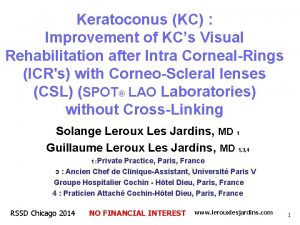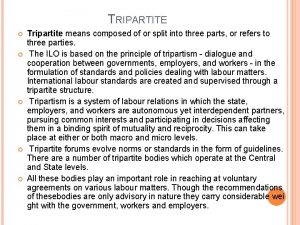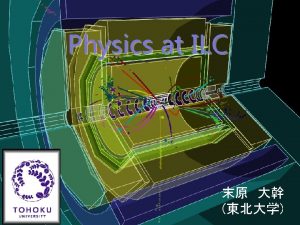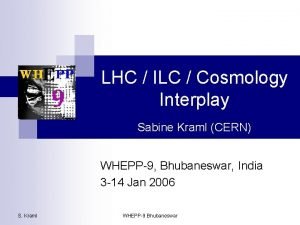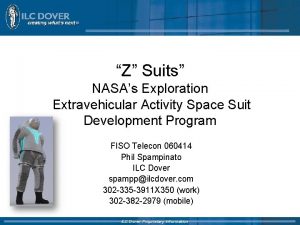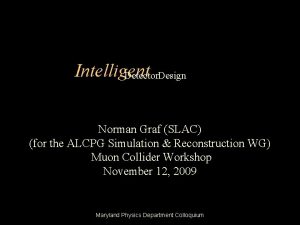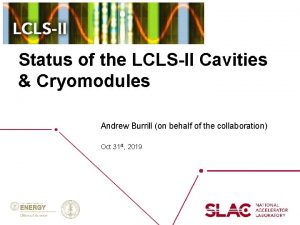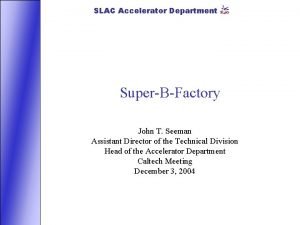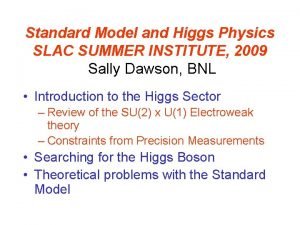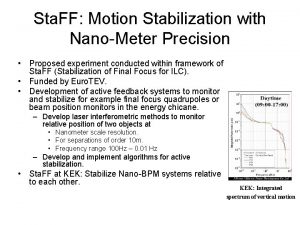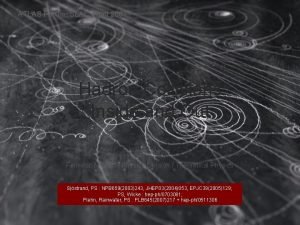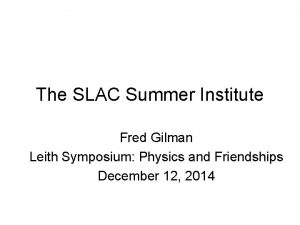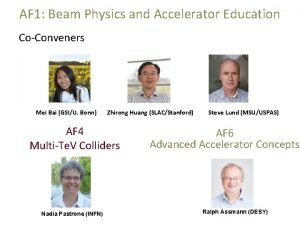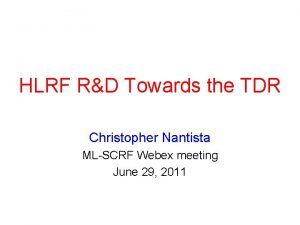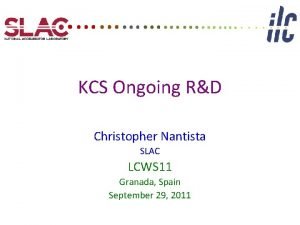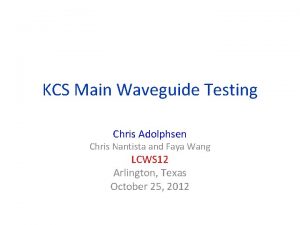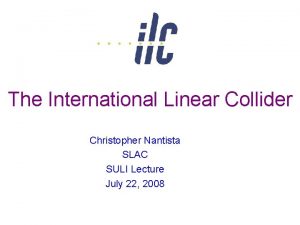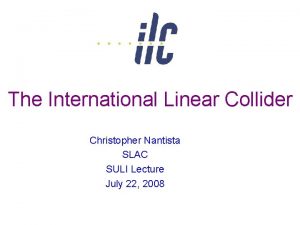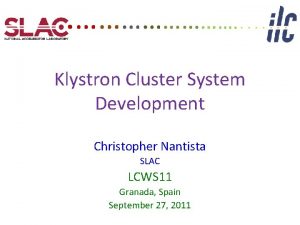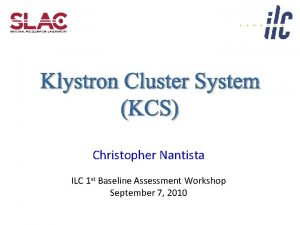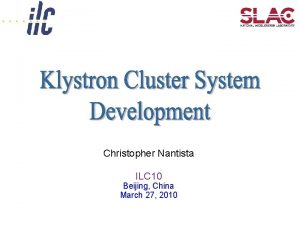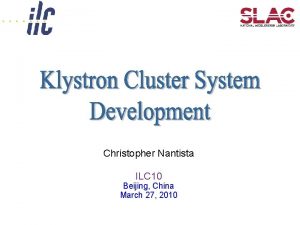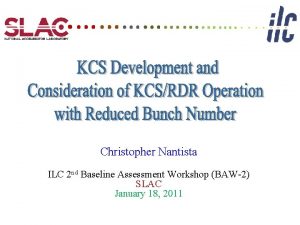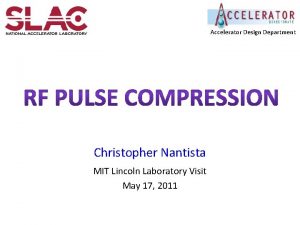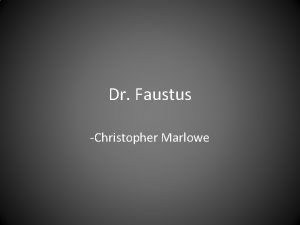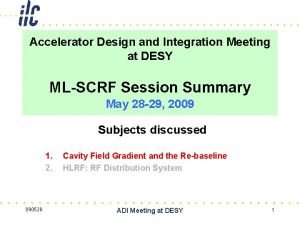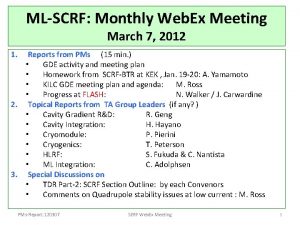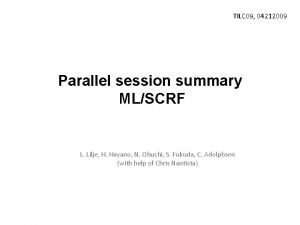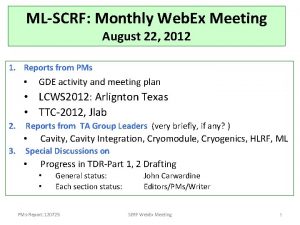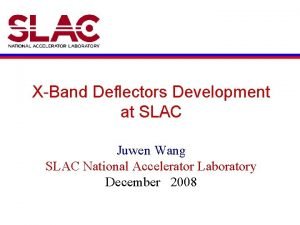HLRF KCS option Christopher Nantista SLAC ILC MLSCRF






























- Slides: 30

. …………. HLRF: KCS option Christopher Nantista SLAC ILC ML&SCRF Baseline Technical Review KEK, Tsukuba, JAPAN January 19, 2012

Beam Current RDR: Is the nominal high-power beam current (2× 1010 e-)×(1. 60218× 10 -19 C/e-) ÷ 369. 23 ns = 8. 6785 m. A 480 cycles or (2. 0741× 1010 e-)×(1. 60218× 10 -19 C/e-) ÷ 369. 23 ns = 9. 0000 m. A? 720 cycles = 553. 85 ns Baseline beam current = 5. 786 A or 6. 000 3. 7% difference

Klystron Cluster System (KCS) Concept • Main linac rf power is produced in several surface buildings and brought down to and along the tunnel in low-loss circular waveguide. • Many modulators and klystrons are “clustered” to minimize surface presence and number of required shafts. ADVANTAGES • Power from a cluster is combined and then tapped off in equal • equipment accessible amounts at 3 -cryomodule (RDR rf unit) intervals. for maintenance space for additional sources for high power upgrade CTO KLYSTRON CLUSTER BUILDING • tunnel size smaller than for other options • underground electrical power and heat load greatly reduced CTO ACCELERATOR TUNNEL ~2 km of linac powered per 2 -cluster shaft. 12 shafts total for both linacs. CTO

Combining and Dividing Power A novel waveguide device was developed for coupling into and out of the low -loss circular TE 01 mode waveguide without creating large surface fields. CTO (Coaxial Tap-Off) Tunnel Cross-Section CTO (initial concept) determines coupling Couplings ranging from ~1 to 1/33 are required. D =5 m For combining, the tap-offs are used in reverse. Proper phase and relative amplitude needed for match (mismatched power goes to circulators). Replace vacuum windows w/ smaller pressure windows. Eliminate combiner and add two high-power circulators. CTO’s of increasing coupling every ~38 m bend ~1/26 ~1/25 … C = ~1/2 C = ~1

KCS Shafts and RF Units per KCS 1/6/12 Latest Changes: • Back to 9 -8 -9 (26 cavity) rf units. • 2 nd stage bunch compression at 15 Ge. V 10 Ge. V moved from each main linac to an “RTML 2”. Since the latter are in-line w/ the main linacs, we can power them with upstream KCS’s running past the BC’s from the first shaft at the start of each main linac proper, which is itself powered with the remaining 11 KCS’s. RTML 2’s: 10 Ge. V (31. 5 Me. V/m× 1. 038 m/cav. ) = ~306 cav. 26 cav. /rf unit = 11. 77 rf units, but 15 requested (running off-crest) RTML 2: 15 rf units Main Linacs: (250 Ge. V– 15 Ge. V) (31. 5 Me. V/m× 1. 038 m/cav. ) = 7, 187 cav. ’s 7, 187 cav. 26 cav. /rf unit = 276. 4 rf units e+ ML: 277 rf units (9× 25 + 2× 26) e- ML: 281 rf units* (5× 25 + 6× 26) I. P. undulator 26 26 26 25 25 -- main facilities shaft -- additional KCS shaft 25 25 25 e- beam 15 25 25 25 e+ beam 25 25 26 26 I. P. total: 588 rf units (15+281 + 15+277) 1, 764 cryomodules 15, 288 cavities *4 more to restore up to 3. 4 Ge. V loss in undulator. 15

Low Power (new baseline) Pulses KCS is very flexible. Combining tens of klystrons allows us to adjust installed power with relatively fine granularity. Fixed tb: Simply eliminating every other bunch (halving f. B) maintains the beam duration and halves the current, cutting in half the required peak power. However, it also doubles the cavity fill time. , thereby increasing the required rf pulse width at full gradient by 38%. (Prf → ½ Prf 0, trf → 1. 38 trf 0) Fixed trf: It’s preferable to adopt parameters which allow use of the modulators and klystrons developed for full RDR beam specifications, i. e. to stay within the ~1. 6 ms pulse width. This can be achieved by reducing the bunch spacing to increase the current to 0. 69 I 0. The rf peak power required at the cavities is reduced from that for the full beam by this factor. (Prf → 0. 69 Prf 0, trf → trf 0) (~9 m. A)

KCS Main Waveguide Loss s = 2. 459 107 W-1 m-1 (6061 -T 6 Al) f = 1. 3 GHz (k 0 = 27. 246 m -1) ds = ( 0 pfs)-1/2 Rs = 1/(sds) = 0 pf/s = 0. 0144 a = 0. 24 m c 0, 1 = 3. 8317 TE 01: = 6. 771 10 -5 m-1 For a = 0. 1746 m: = 2. 404 10 -4 m-1 rf unit waveguide length WC 1890: 37. 956 m - 1. 326 m = 36. 63 m WC 1375: 1. 326 m Power attenuation per rf unit length (6061 Al): e-2(a 1*L 1+a 2*L 2) = 0. 9944 (~0. 558% ) power flow at each CTO: condition for equal rf unit powers: CTO couplings: N = 26, e-2 a. L = 0. 9944 power/rf unit normalized to P 1: 3. 582% total: 93. 14% ~6. 86% Attenuation loss along tunnel: Shaft waveguide (~75 m? ) power transmission: 3 Bends + tapers power transmission: TOTAL KCS waveguide ohmic loss 0. 9899 0. 9922 ~8. 52%

from BAW 1 Sept. 2010 Needed Power at Cavities With the given distribution of cavities and sorting prescription, there will still be some statistical spread in how much power each rf unit needs. Since the CTO’s will not be adjustable, excess power will have to be provided to accommodate most (97. 5%? ) units. With no adjustment to the split between halves of an rf unit, the statistics are over 13 cavity feeds, or 1/2 rf units. The difference is marginal. Mean: 5. 89% over nominal (294. 3 k. W) Mean+2 std (97. 5%): 12. 49 % over (12. 15% w/ feed division adjustment) 5. 9% reflected, 6. 6% into end loads mean + 2 std (97. 5%) = 8. 5807 MW 2 (mean+2 std) = 8. 607 MW (0. 307% more) Mean: 8. 1018 MW Std: 239. 45 k. W Mean: 4. 0509 MW Std: 126. 30 k. W

Effect of Tunnel CTO Coupling Errors in the coupling coefficients of CTO’s will lead to a spread in the total peak power available at each rf unit. With a flat distribution of random errors between ± 0. 2 d. B, an extra ~5% power is needed to guarantee nominal power available at each rf unit.

Assume 2. 5 m CTO spacing (WC 1375), e-2 al = ~0. 998799 Also assume equal klystron powers and perfect phasing. CTO couplings for equal power: Nominal ohmic combining loss: ~1. 898% Nominal CTO Couplngs Effect of Combining CTO Coupling Errors 33 KCS Klystrons One Klystron Off and ± 0. 2 d. B Errors Statistical Distribution 1 st off mean: 0. 9234 min: 0. 9203 (vs. 0. 94) One off factor, no attn. : (32/33)2 = 0. 9403 Another ~2% effectively lost due to combining errors of this scale.

from BAW 1 Sept. 2010 Achieving Flat Gradient Flat acceleration across the beam pulse is important for maximizing gradient. With control of power, Qe, and fill time, a steady state match can be achieved at the desired gradient in a cavity, giving constant acceleration with no power is reflected during the beam pulse. With KCS, 748 cavities are locked to a common source timing. With power and Qe adjustable, a steady state constant gradient is still achievable, but there will generally be some level of power reflected. Power Needed for Flat Acceleration Blue: timing set for zero reflection at center gradient Red: timing set for zero reflection 5% below center gradient Normalized to 31. 5 MV/m × 1. 0377 m × 9 m. A = 294. 2 k. W Mean: 1. 0533 Mean: 1. 0426 20% spread example For a given distribution of gradients, the timing can be set so as to minimize the average reflected power, not necessarily at the point where the center gradient is matched. For upstream(downstream) KCS systems, the effective spread in fill time is ~7. 64(0. 40) s. This is roughly 1. 28%(. 07%) of the nominal fill time and has little effect on efficiency.

Peak RF Power Required from Klystrons per KCS feeding 26 26 -Cavity RF Units (Low Current) 189. 3 k. W × 1. 059 × 1. 062 × 26 ÷ 0. 931 ÷ 0. 982 ÷ 0. 981 ÷ 0. 965 ÷ 0. 977 185. 00 MW (nominal to beam per cavity = 31. 5 MV/m 1. 038 m 5. 79 m. A) (for flat gradient w/ cavity gradient spread and common timing) (for statistical spread in feed/rf unit requirements w/ fixed couplings) (cavities/rf unit) (8% local distribution losses) = 6. 017 MW/rf unit @ CTO (rf units) (6. 9% main waveguide losses) = 168. 03 MW @ beginning of linac run (shaft and bends) (1. 9% combining CTO circular waveguide losses) ~9. 1% (input circulator and WR 650 losses) klystron-to-tunnel (CTO coupling/klystron amplitude mismatches) from klystrons

Klystrons Needed per KCS (Low Current) The calculation/estimate suggests we need generate ~185 MW worth of klystron power for a 26 rf unit KCS at Ib = 5. 79 m. A. However, we need 7% (5% usable) overhead for LLRF to be harnessed via phase control of the rf drives, oppositely dephased in pairs, such that the combined power is reduced as P = Pmax cos 2 , with nominally 15˚. The maximum power requirement rises to 185 MW/0. 933 = ~198. 3 MW. We also want to be robust against a single klystron failure per system. With N sources combined in a passive network, failure of one source leaves combined the equivalent of (N-1)2/N sources. With 21 klystrons and 20 on, we have 190. 5 MW available (~4% short). With 22 klystrons and one off, we have 200. 45 MW (~1% to spare). 21 klystrons for the 25 unit KCS (need ~190. 7 MW) 14 klystrons for the 15 unit KCS (need ~114. 4 MW) TOTAL: 8× 22 + 14× 21 + 2× 14 = 498 klystrons installed (474 on)

Klystrons Needed per KCS (High Current) The calculation/estimate suggests we need generate ~277. 3 MW worth of klystron power for a 26 rf unit KCS at Ib = 8. 68 m. A. However, we need 7% (5% usable) overhead for LLRF to be harnessed via phase control of the rf drives, oppositely dephased in pairs, such that the combined power is reduced as P = Pmax cos 2 , with nominally 15˚. The maximum power requirement rises to 277. 3 MW/0. 933 = ~297. 2 MW. We also want to be robust against a single klystron failure per system. With N sources combined in a passive network, failure of one source leaves combined the equivalent of (N-1)2/N sources. With 32 klystrons and one off, we have 300. 3 MW (~1% to spare). 31 klystrons for the 25 unit KCS (need ~285. 8 MW) 20 klystrons for the 15 unit KCS (need ~171. 5 MW) TOTAL: 8× 32 + 14× 31 + 2× 20 = 730 klystrons installed (706 on)

Evolving KCS Parameters 10 Ge. V RTML but included, rf units added from RTML 9 -8 -9 8 -8 -8 half bunches 8 -8 -8 9 -8 -9 9/2010 (BAW 1) 3/2011 (ALCPG 11) 9/2011 (LCWS 11) TDR (LCWS 11) 1/2012 (BTR) # of shafts / main linac 5 6 6 # of KCS systems / main linac 10 11 11 12 11 + 1(RTML) # of rf units / main linac (e+/e-) 280/284 290/294 314/319 277+15 / 281+15 # of rf units (CTO’s) / KCS 28 27 29 27 (22) 25 26, 15 linac length fed per KCS (km) 1. 064 1. 026 1. 024 0. 994 0. 950 0. 988*, 0. 57 # of cryomodules / KCS 84 81 87 81 75 78, 45 # of cavities / KCS 728 702 696 648 650 676, 390 # of klystrons/mod. ’s / KCS 34 33 33 22 (18) 21 22, 14 peak rf power / system (MW) 340 installed 330 gen. 320 into sys. 330 inst. 320 gen. 310 in 220 inst. 210 gen. 200. 5 in 220 installed 210 generated 200. 5 into system * plus end box lengths, etc.

Source Failure in Combining Circuit The scattering matrix for an ideal, lossless, 1/n-coupling matched 3 -port junction (e. g. a CTO) is of the form: 2 1 3 Using the junction in reverse for combining, the normalized input powers of n-1 and 1 respectively in ports 2 and 3 combine as n out of port 1 with no reflections. If the port 3 input drops out, a normalized output power of 1 - 1/n is seen in port 3. As the power balance at all downstream combining junctions will be thrown off, there will also be some reflection into port 1, which will affect the port 3 output. 2 1 Looked at another way, if each input junction ultimately contributes equally to the final combined output field: 3 Then, if one source fails, we’re left with: With one unit less power going in, this means 1 - 1/N is misdirected, primarily toward the failed klystron, which no longer has its self-reflected field to cancel the field from the pipe. So, with N large, on the order of 5 MW reverse power can be expected in each feed arm of a failed klystron.

Klystron to CTO Connection 5 MW circulators (isolators) protect klystron during operation and prevent reflection into system of mismatched/emitted fields from KCS waveguide. Remote-controlled mechanical rf switches can provide additional isolation from KCS waveguide power in case of klystron (or circulator) failure, allowing maintenance/replacement during operation (with spare klystron turned on to maintain power). KLY 5 MW circulator window CTO switch + 5 MW load

Old RDR Power Distribution System

Phase Shifter for Local Power Tailoring Assembly incorporating 2 phase shifters + 2 hybrids can replace VTO. Phase shifter range of 0°– 90°, the above arrangement allows full range power division. If 1 and 2 are moved equally in opposite senses, the output phases are unaffected. Pressurizable U-Bend Trombone Phase Shifter combine with Folded Magic-T cold tests: transmission: -. 03. 01 d. B reflection: -50 36 d. B high-power test: No breakdown in 8 hours at ~2 MW in 1 bar N 2. Mega Industries BENEFITS: • more compact longitudinally than VTO (for individual cavity feeding) • motorizable for remote adjustment (crucial with cavity degradation)

New Fully Adjustable Local PDS Unit To accommodate optimal power division among sets of cavities with a sustainable gradient spread of ± 20%, not necessarily knowable before installation in CM and susceptible to degradation over time, we opt for a fully and remotely adjustable local power distribution scheme. We thus hope to make maximal use of the cavities at the cost of a more expensive PDS. The need for pre-sorting into matched pairs, introduced by a previous approach aimed at eliminating the need for circulators, has been removed. However sorting to produce more uniform power requirements per feed may still be useful end-on views Reorient to eliminate a bend. Pairs of folded magic-T’s and motorized U-bend phase shifters provide coupling adjustment, while preserving phase. to cavity coupler window circulator dummy load flex guide phase shifter bi-directional coupler

Local PDS Circuit KCS waveguide 9 CTO 4 Q Use circulators and r. c. switches (as in combining circuit) respectively to shield KCS from reflections and, if necessary, to depower 1½ CM’s. 4 9 By splitting CTO outputs through asymmetric (-5. 12 d. B) “hybrids”, as in the RDR, we can physically decouple cryomodules and limit variable coupler cascading.

RDR-Like Option (Low Power) With the “kamaboko” tunnel design offering a virtual return to the 2 -tunnel scenario, an RDR-like layout w/ 10 MW klystrons, modulators, etc. is now a serious option. kamaboko tunnel For the new low power (half bunches) baseline beam, one could double the bunch spacing and install half the modulators and klystrons, each feeding 6 CM’s, rather than 3. FULL BEAM HALF BEAM Prf → ½ Prf 0 trf → 1. 38 trf 0 every other klystron omitted However, this would double the fill time, increasing the required rf pulse width by 38%. The installed modulators and klystrons would then be overspec. ed for the upgrade.

Alternatively, one could install 2/3 of the rf production equipment, with each klystron feeding 4 ½ CM’s. This would reduce the available power per cavity, and thus the acceleratable beam current or bunch frequency, by a factor of ~2/3 vs. RDR. Prf → 2/3 Prf 0 trf → 1. 035 trf 0 every 3 rd klystron omitted The beam pulse duration ( n. B/Ib → ½ / 2/3) is then shortened by a factor of ¾, and the fill time increased by a factor of 3/2, yielding an rf pulse width increase of only ~3. 5%. As this seems acceptable, we adopt 2/3 current, rather than 69%, as the new baseline for both HLRF options (KCS and RDR-like).

Relevent Changes from RDR 9/2011 RDR TDR particles/bunch 2. 074 1010* 2. 074 1010 bunch spacing 369. 23 ns (480 cycles) 535. 4 ns 553. 8 ns (696 cycles) (720 cycles) beam current 9. 0 m. A 6. 207 m. A 6. 000 m. A 33. 3% rf pulse cavity power 294. 3 k. W 202. 94 k. W 196. 2 k. W 33. 3% Pb 50% cavity fill time 596 s 864. 2 s 894. 0 s bunches/pulse 2625 1312† bunch train length 968. 9 s 701. 9 s 726. 1 s 25% rf pulse length 1. 565 ms 1. 566 ms 1. 620 ms 3. 5% cavities per rf unit 26 24 24 5. 6% *adjusted slightly for consistency from published value of 2 1010. .

from Jan. /Feb. 2011 Parameter Summary 250 Ge. V/beam # of bunches bunch spacing beam current beam duration rf peak power fill time, ti rf pulse duration full beam 2625 369. 2 ns 9 m. A 0. 969 ms 294. 3 k. W 0. 596 ms 1. 565 ms 460. 6 J ½ bunches A 1313 738. 5 ns 4. 5 m. A 0. 969 ms 147. 1 k. W (down 50%) 1. 192 ms 2. 161 ms (up 38%) 317. 9 J ½ bunches B KCS? 1313 535. 4 ns 6. 207 m. A 0. 7019 ms 203. 0 k. W (down 31%) 0. 864 ms 1. 566 ms ½ bunches B RDR-like 1313 553. 8 ns 6 m. A 196. 2 k. W (down 33%) 0. 894 ms 1. 620 ms 317. 8 J (up 3. 5%) 69% 480 cycles 960 cycles 696 cycles 720 cycles 0. 7261 ms @ 31. 5 MV/m Parameter choice also impacts cryogenic load. ----- cryo load increase* full beam ½ bunches A ½ bunches B (KCS) ½ bunches B (RDR) 0% 40. 6% 1. 9% 5. 5% * Only includes dynamic load of fundamental rf in cavity. Additional contributions come from coupler (linear w/ power and time) and HOM (current dependent). 317. 9 J

High Power Upgrade The power upgrade would double the beam power at the same Co. M energy. • • Double number of bunches/pulse. Change bunch spacing s. t. beam current increases only 50%. Add 47 -50% more sources (klystrons, modulators, etc. ). Modify rf “plumbing”: KCS – tie new sources into KCS’s w/ CTO’s. RDR-like – install penetration waveguides and remove splitters and feeds from neighboring rf units. • Adjust cavity couplings and timing to new beam structure. • Accommodate new AC (1. 5/1. 035 ~45%), water cooling (~40%) and cryogenic demand increases.

Cost Scaling The “economy of scale” cost reduction might vary significantly among components depending on such factors as the market size and the fabrication technology. Following the RDR, I initially used a “learning curve” factor of 0. 95 per doubling. A major vendor has suggested that after ~100 units, the cost per unit no longer decreases, bottoming out at ~0. 75×the cost for 4. In the following tables, I’ve largely applied this more conservative scaling. 0. 95/doubling vendor’s projection 1 10 100 1, 000 100, 000

Item Reduced total cost Component Cost Estimate fornumber KCS unit upcostto Tunnel CTO’s* 10 MW MBK’s 498 Marx modulators 498 CTO’s (26 types) 516 kly +633 rf units 2 per CTO 5 MW circ. ’s 996 5 MW switch 996 block windows TE 01 bends diam. tapers 2×(633 + 72) = 1, 410 26×(37. 956 m - 2× 1. 326 m) + 50 m = ~968 m 21×(37. 956 m - 2× 1. 326 m)+50 m = ~791 m 21× 968 m + 3× 791 m = 22. 7 km 22. 7 km/8’ = ~9, 310 * Hardware only. 1, 086 end caps 2, 172 72 1, 152 48 WR 650 dir. cplrs. 996 E-plane bends (p) 1, 992? H-plane bends (p) 996? flex guides 1, 992 8’ (2. 44 m) WC 1890 pipes 9, 310 large TE 01 rf spring seals 10, 015 small TE 01 rf spring seals 1, 950 rubber O-rings 11, 965 Total

Component Cost Estimate for Local PDS* Item 15, 288 cav. ’s number unit cost reduced 2’ WR 650 section (p) 2, 940 8’ WR 650 section (p) 2, 940 E-plane bend (p) 5, 880 H-plane bend (p) 1, 176 5 MW loads 2, 352 5 MW switch 1, 176 5 MW circulators 1, 176 flex guides (p) 4, 704 1 MW loads 17, 640 folded magic-T’s (p) 30, 576 pressure windows 15, 288 H-plane bend 15, 288 400 k. W circ. ’s 15, 288 WR 650 phase shifters 15, 288 E-plane U bends 15, 288 WR 650 bi-dir. cplrs. * Hardware only. 15, 288 Total total cost

AC Power and Cooling Requirements (KCS) For both main linacs, including second RTML stage LOW POWER Average rf power: 474 klystrons× 10 MW× 1. 62 ms× 5 Hz = 38. 4 MW Average beam power: 5. 79 m. A× 490 GV× 726 s× 5 Hz = 10. 3 MW (26. 8%, 59. 8% during beam -- 44. 8% of pulse width) wall plug–modulator pulse efficiency: ~87% modulator pulse–HPRF efficiency: ~65% wall plug – HPRF: ~57% 38. 4 MW / 0. 57 = 67. 4 MW AC 67. 4 MW(AC) – 10. 3 MW(beam) = 57. 1 MW cooling HIGH POWER Average rf power: 706 klystrons× 10 MW× 1. 62 ms× 5 Hz = 57. 2 MW Average beam power: 8. 68 m. A× 490 GV× 969 s× 5 Hz = 20. 6 MW (36%, 58% during beam – 61. 9% of rf pulse width) wall plug – HPRF: ~57% 38. 4 MW / 0. 57 = 100. 35 MW AC 67. 4 MW(AC) – 10. 3 MW(beam) = 79. 75 MW cooling
 Option a option b
Option a option b Bssd adalah
Bssd adalah Direct to indirect speech
Direct to indirect speech Dnevna bolnica psihijatrija kcs
Dnevna bolnica psihijatrija kcs Fekonditet
Fekonditet Kcs toolbox
Kcs toolbox Knowledge center
Knowledge center Kcs vle
Kcs vle Kcs academy chicago
Kcs academy chicago Klinika za psihijatriju kcs
Klinika za psihijatriju kcs Kcs device agreement
Kcs device agreement David,i
David,i Zora rutar ilc
Zora rutar ilc There are....tripartite committees at the national level..
There are....tripartite committees at the national level.. Ilc brno
Ilc brno Ilc 2013
Ilc 2013 Spectrum ilc 1002
Spectrum ilc 1002 Ilc 150 eth
Ilc 150 eth Zsuits
Zsuits Confluence slac
Confluence slac Andrew burrill slac
Andrew burrill slac Slac
Slac Slac summer institute
Slac summer institute Network data collection at slac
Network data collection at slac Slac protocol
Slac protocol Stanford remote desktop
Stanford remote desktop Slac sta
Slac sta Slac
Slac Slac summer institute
Slac summer institute Mei bai slac
Mei bai slac Slac vpn
Slac vpn








